Tanacetum coccineum
A painted daisy is proof that you can’t judge a book by its cover. Or rather, that you can’t judge an effective bug-killer by its beautiful blooms.
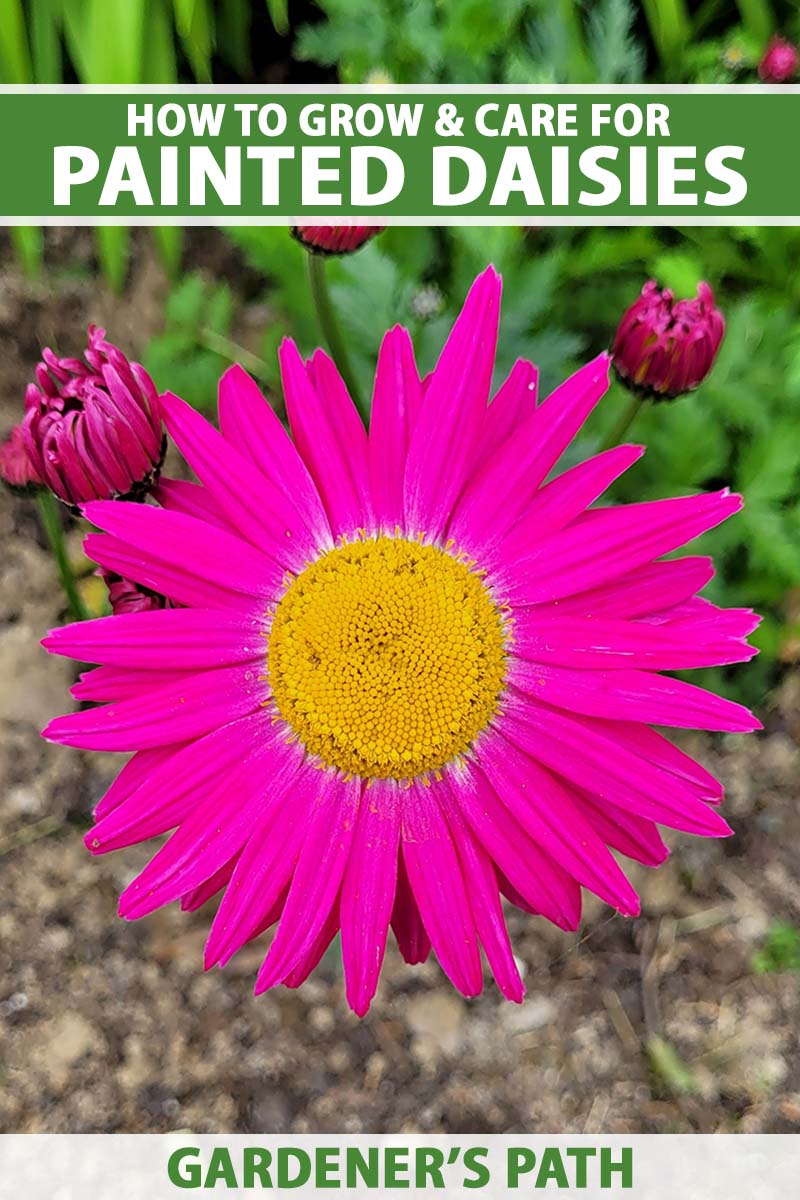
We link to vendors to help you find relevant products. If you buy from one of our links, we may earn a commission.
On the surface, Tanacetum coccineum is an absolutely gorgeous perennial.
With its extremely striking hues, this daisy truly does look painted, as if Georgia O’Keeffe herself took some red, pink, and/or purple pastels directly to the petals.
But contained within the flowers are pyrethrins: a group of naturally-occurring compounds which, when consumed, wreak havoc on a bug’s nervous system.
As a result, bugs tend to steer clear of these bad boys, making the painted daisy a fine choice for organic pest management.
Growing and caring for these flowers is pretty simple, but a primer will definitely give you a leg up on T. coccineum cultivation. Hence, this guide.
Here’s what you’ll be getting into:
What You’ll Learn
What Are Painted Daisies?
Hardy in USDA Zones 3 through 7 and native to southwestern Asia, painted daisies are a spectacular species of herbaceous perennial flower, belonging to the Asteraceae family alongside cosmos, dahlias, and marigolds.
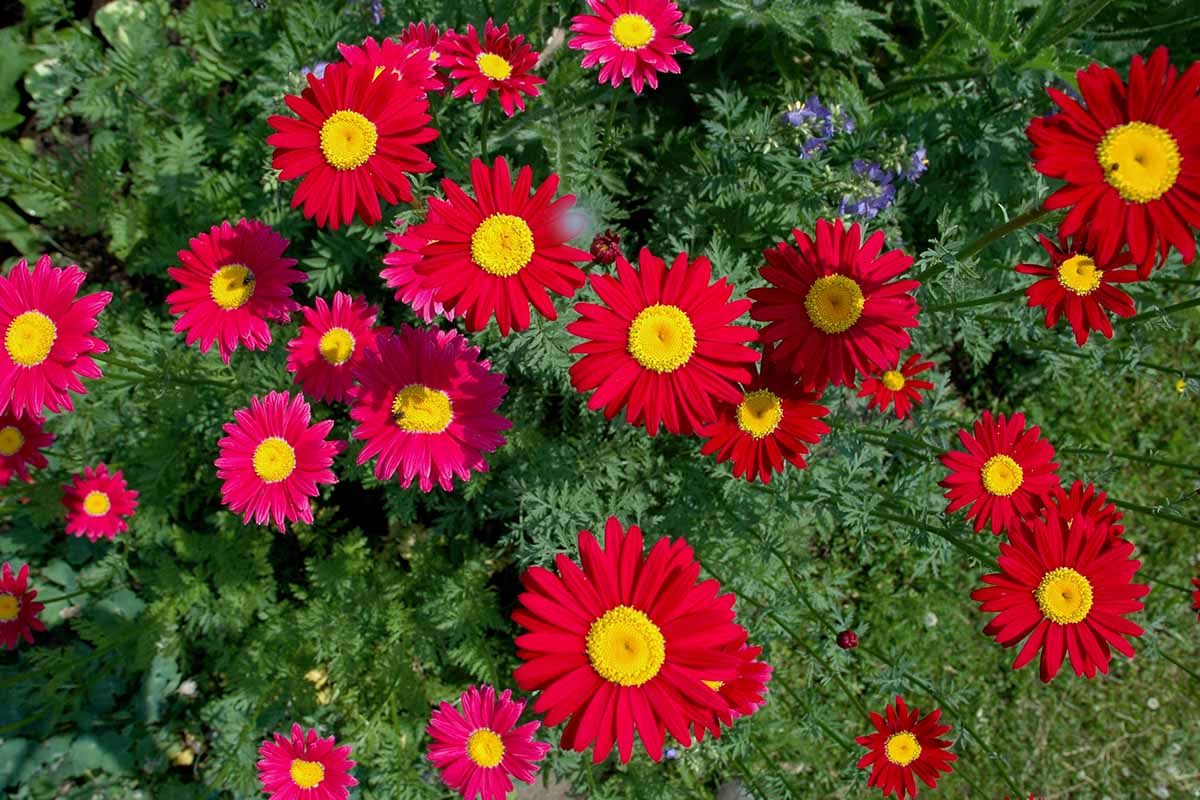
The painted daisy goes by other common names, such as the pyrethrum, pyrethrum daisy, and Persian insect flower.
In binomial nomenclature, former names include Chrysanthemum coccineum, C. roseum, and Pyrethrum roseum.
Tanacetum coccineum has a fun meaning. From the Greek athanasia – meaning “immortality” – comes the genus name, which references the everlasting nature of Asteraceae blooms.
The species name coccineum means “scarlet” or “crimson,” a nod to the sometimes red petals.
Since many plants bear the name “daisy,” it’s important to distinguish T. coccineum from the rest.
With an upright, bushy, and clumping habit, these plants reach two to three feet tall and one to one and a half feet wide at maturity. Flaunting a pleasantly earthy aroma, T. coccineum produces showy, three-inch-wide flowers from June to July atop thin, wiry stems.

Unsurprisingly, these blooms have that pluckable daisy-like aesthetic, with long and slender ray petals – perfect for discerning whether that special someone loves you or not.
The typically single, occasionally double flowers have yellow centers and pretty petals that come in white, red, pink, or purple hues.
Soft, fern-like leaves are produced in an alternate arrangement below the blooms, increasing in size and petiole length as you move down the stem.
Thankfully, T. coccineum doesn’t grow invasively or aggressively… although the same can’t be said for its close relative T. vulgare.
Fun fact: T. coccineum contains pyrethrins in its flowers, which are organic compounds with bug-killing properties.
With a high toxicity to insects and a low toxicity to birds and mammals, these pyrethrins over-excite a bug’s nervous system when ingested, which quickly leads to the insect’s paralysis and death.
If you’re allergic to members of the Asteraceae family – you probably are if you have a ragweed allergy – then contact with the sap or leaves of a painted daisy could cause a bit of skin irritation.
It never hurts to break out your handy gardening gloves!
Cultivation and History
The cultivation of pyrethrum daisy for its insecticidal properties spans centuries, with records of its usage going all the way back to ancient China’s Chou dynasty in the first century CE.

The Dalmatian pyrethrum, aka T. cinerariifolium, is cultivated for its pyrethrins more commonly in commercial production than T. coccineum.
A solvent is used to extract these from the dead flower heads.
While both species contain significant amounts of pyrethrins, T. cinerariifolium has far higher concentrations, making it more effective in yielding insecticide.
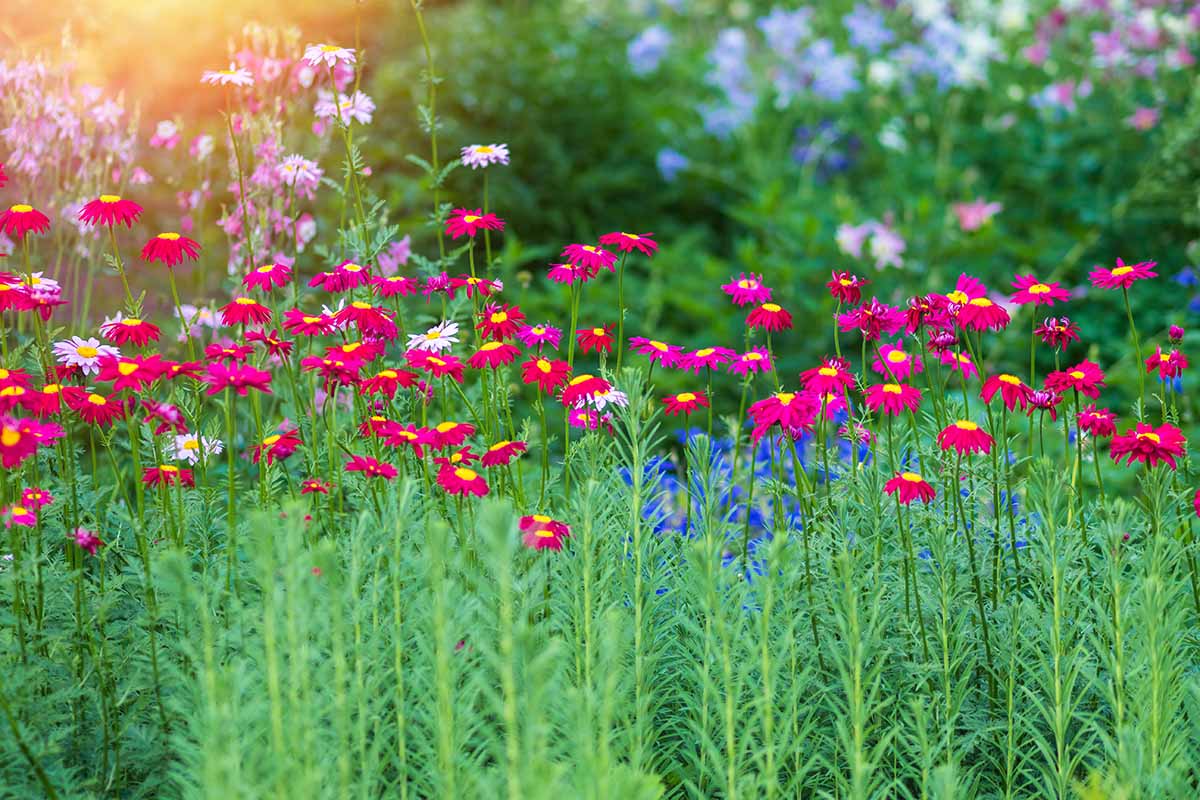
In the case of painted daisies, the insecticide derived from this species has a long history of use in the Caucasus Mountain region, and the daisy was once commonly known as “Caucasian insect-powder plant.”
The locals knew the power of their insect powder, and sold it to outsiders at high prices while keeping its true botanical origins a secret… until the early 1800s, at least.
At that time, an Armenian merchant known as Mr. Jumtikoff learned where the insect powder came from and how it was made. In 1828, his son began large-scale production.
By the mid-1800s, Caucasian insect powder had reached central Europe, with another merchant taking credit for the majority of its success in the market: the German-born Johann Zacherl.
He sourced the flower from rural Caucasian communities, ground it up in what’s now the modern-day nation of Georgia, then procured the processed powder in the Austrian city of Vienna, selling it as “Zacherl’s Insect Killing Tincture,” or “Zacherlin.”
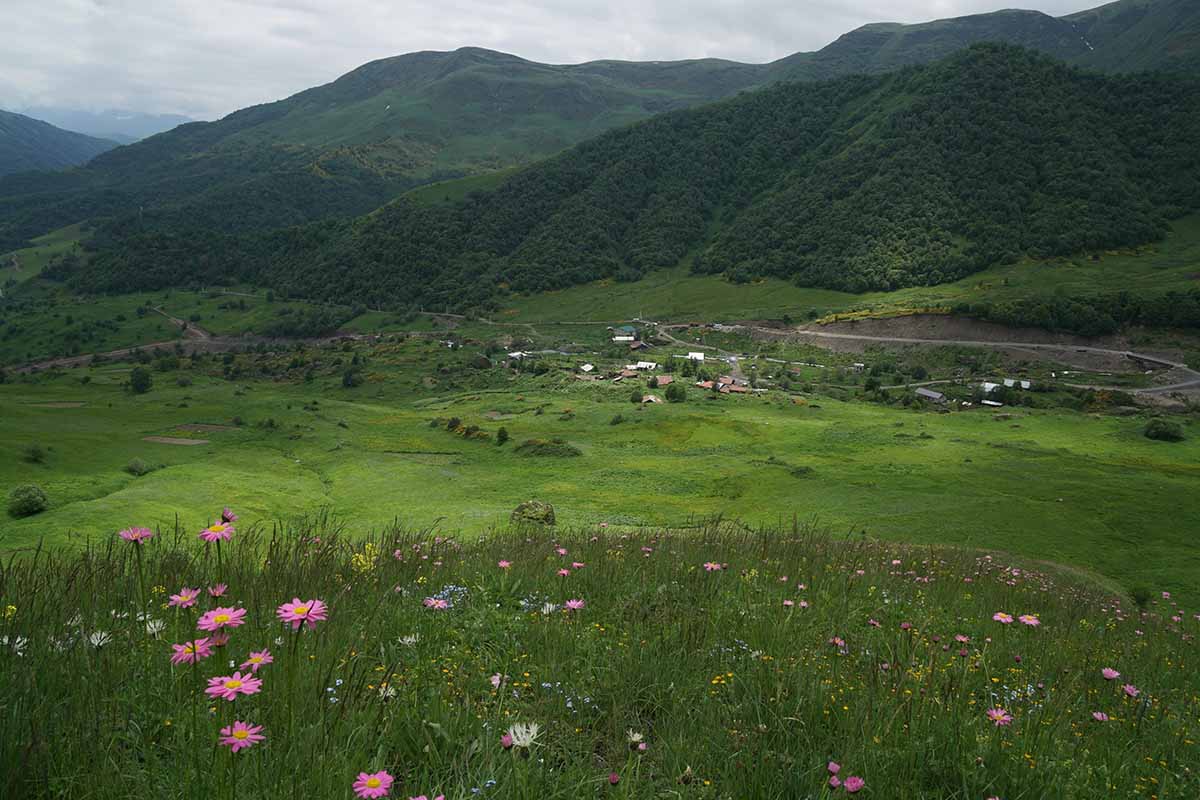
By 1880, Zacherl’s son had taken over the firm, and replaced painted daisies with the more pyrethrin-dense T. cinerariifolium.
Its higher concentration of insect-killing compounds makes the Dalmatian pyrethrum the more lucrative choice for pesticide production.
In the modern-day, pyrethrum is commonly used as an organic pest management tool among both commercial farmers and amateur gardeners.
And after studying its modes of action, scientists have actually been able to synthesize pyrethroids, a manmade counterpart to au naturel pyrethrins.
All of this we owe, in part, to the humble painted daisy.
Propagation
Want some painted daisies of your very own? Then you’ll have to grow them from seed, procure divisions, or acquire T. coccineum transplants.
From Seed
Seeds can be sown directly outdoors after your area’s last frost date. Alternatively, you can actually sow them indoors four to six weeks before the final frost, if you’d like a head start.
For indoor sowing, fill a cell tray with a 50:50 mix of sphagnum peat moss and perlite.
Sow one seed per cell, and gently cover each with about an eighth of an inch of media. Moisten the soil, set the tray near a sunny window, and maintain ambient temperatures of 60 to 70°F.
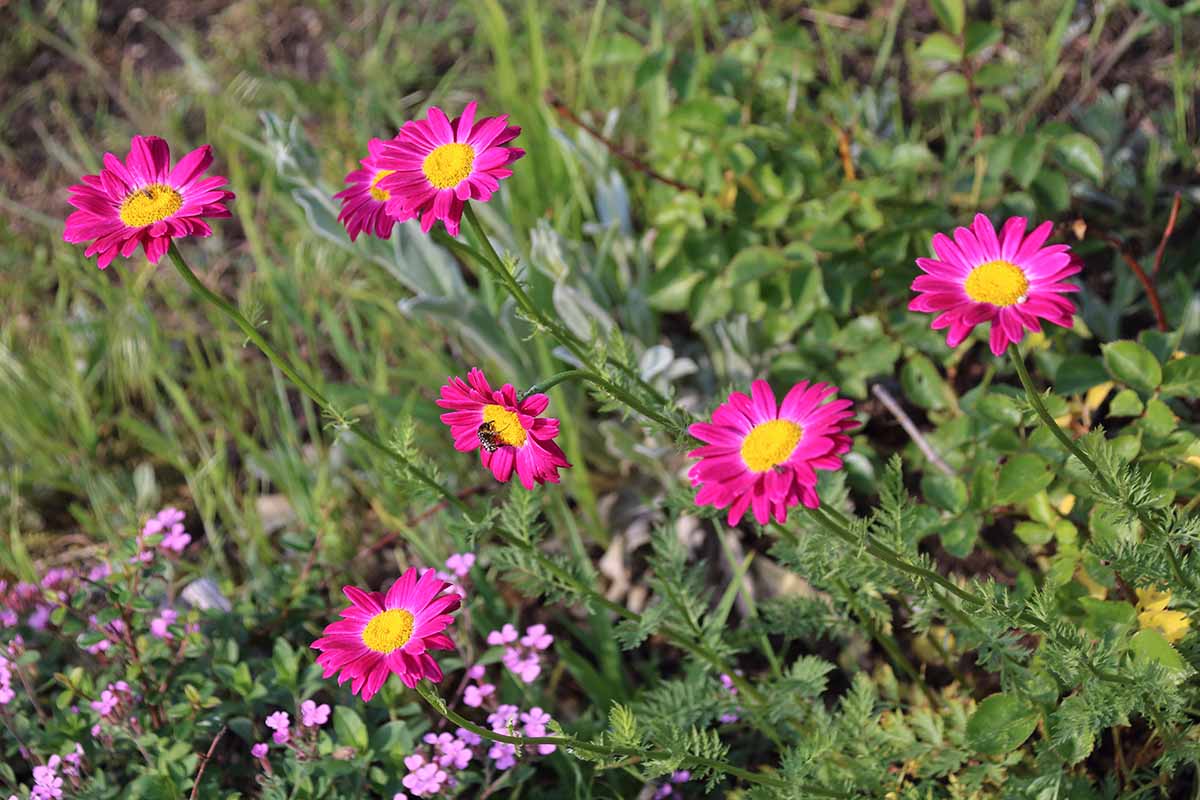
Maintain moist media all the while, and germination should occur in about two to four weeks.
After the final frost date passes two to four weeks later, harden off the seedlings outdoors by leaving the tray outside for 30 to 60 minutes before bringing it back indoors.
Add an additional half to full hour of exposure each following day until your seedlings can survive a full day outside.
At this point, you can transplant the seedlings directly into the ground or into their own three-inch pots, keeping the media moist until they become established.
If you wanted to sow directly outdoors from the get-go, then plant groups of four seeds into well-draining garden soil after the final frost date in spring.
Space these seed groups about 18 to 24 inches apart, cover them with an eighth of an inch of soil, and moisten in the soil. Keep it moist as the seedlings grow and develop.
For freshly-sown, in-ground groups of four seeds, germination should occur in two to four weeks.
As they emerge from the ground, thin out the seedlings until you’re eventually left with the strongest one in each group.
Keep the media moist around the winning seedlings until they become established.
Via Division
After the final frost date in spring, carefully dig up a mature T. coccineum.

Working over a tarp or spread-out newspaper, use your hands or a sharp blade to carefully divide the specimen into two or four daughter plants, with foliage and roots intact.
You can now transplant them into new spots in the garden!
Via Transplanting
Whether it’s with a divided daughter plant, a hardened-off seeding, or a purchased specimen, transplanting a painted daisy is pretty easy.
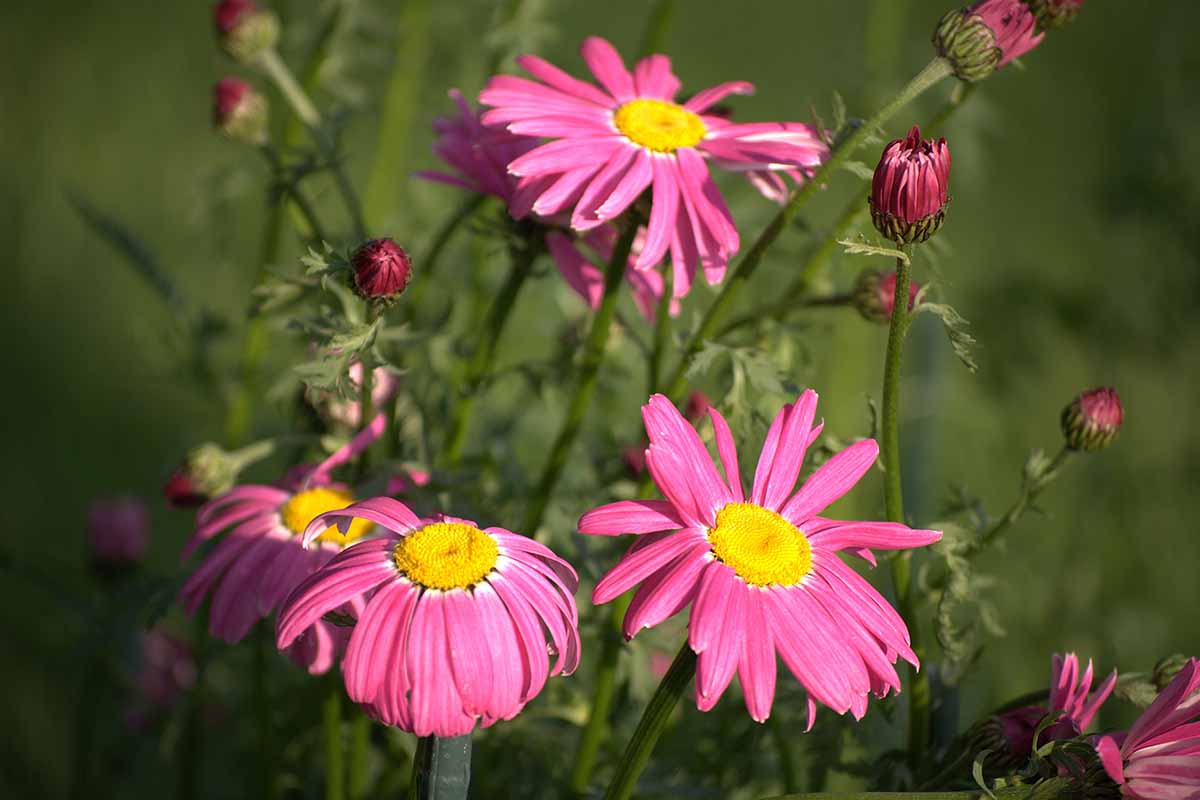
Prepare well-draining planting sites with a pH of 6.0 to 7.0. Space these sites 18 to 24 inches apart, and ensure that they get full sun or partial shade.
Come transplanting time in post-frost spring, dig holes about as deep and a bit wider than the transplants’ root systems.
Set the transplants in the holes, backfill, and water them in. Keep the transplant sites moist until established.
How to Grow
Now that your painted daisies are growing in their new homes, it’s time to keep them happy with proper cultivation!
Climate and Exposure Needs
To survive the extremes of winter and summer, these plants should be grown in USDA Hardiness Zones 3 to 7.

Full sun is best for flowering, but specimens in more southern climates could do with a bit of afternoon shade.
In windy climates, staking T. coccineum may come in handy to keep the slender stems from flopping over.
Soil Needs
As long there’s decent drainage, a painted daisy isn’t too particular about its soil. When it comes to qualities such as texture and fertility, shoot for “moderate” or “average” over any extremes.
Same thing goes for pH – a slightly acidic to neutral range of 6.0 to 7.0 works well.
Water and Fertilizer Needs
Irrigation-wise, keep it moderate by deeply watering whenever the top inch or two of soil feels dry to the touch.
Throughout the growing season, a monthly application of balanced fertilizer will help satisfy the plant’s nutritional needs.

A suitable product for the job would be this 20-20-20 NPK water-soluble fertilizer from Jack’s Classic, available on Amazon.
Growing Tips
- Full sun exposure is best, though partial shade can benefit plants in warmer climates.
- Ensure that the soil is well-draining.
- Water deeply whenever the top one to two inches of soil feel dry.
Pruning and Maintenance
When the plants are six to eight inches tall, pinching back new growth by a third in spring can stimulate profuse flowering and a bushier form overall.
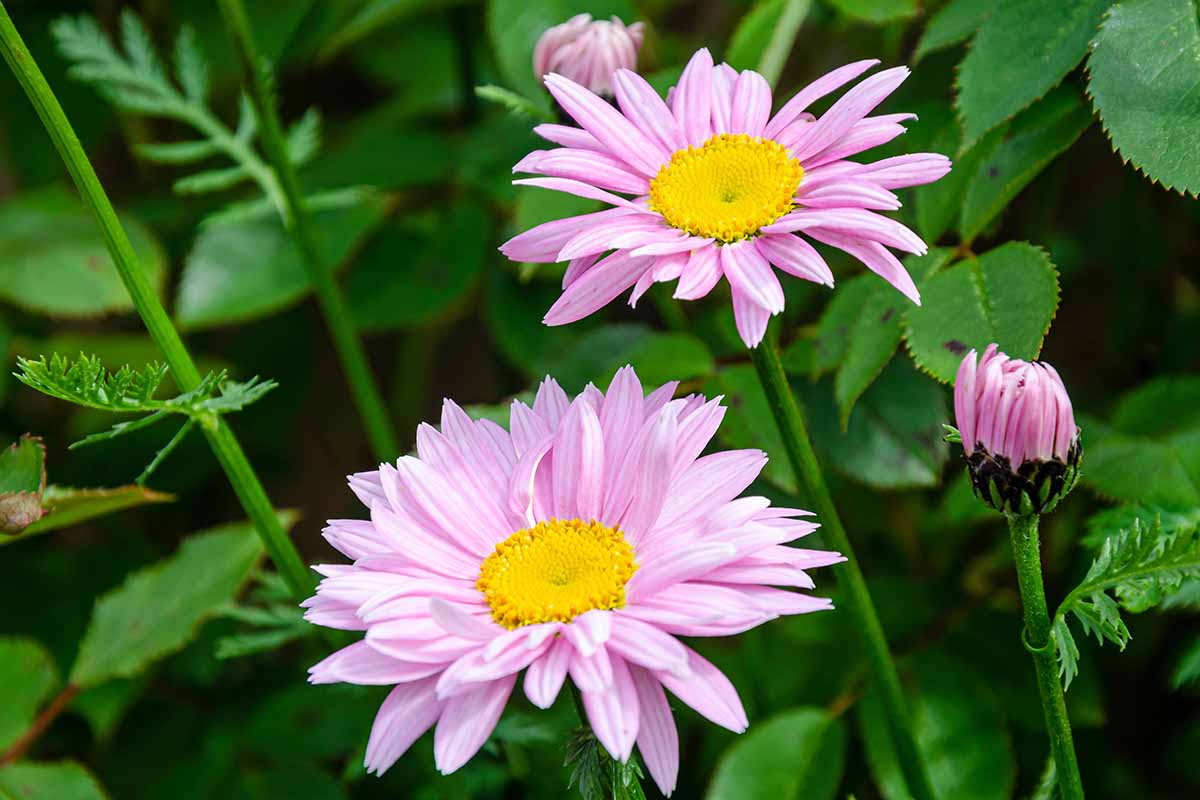
After the first bloom, promptly deadhead spent flowers to encourage a second flush of blooming.
Adding a couple inches of mulch to the root zone around your plants is also a smart move – it’ll conserve soil moisture, insulate the roots, and protect said roots from physical damage.
Cultivars to Select
The cool thing about cultivars is that they offer multiple different aesthetics within a single species. Here’s a few (with fun people’s names!) that I’m sure you’ll love:
Brenda
Can’t decide between red and purple? With its beautiful, magenta-shaded single blooms, the ‘Brenda’ cultivar is the perfect blend of the two hues.
Reaching a mature height of two feet, ‘Brenda’ is sure to bring happy vibes… unless you have an ex named Brenda, in which case it might bring the mood down a bit.
James Kelway
Red and yellow is one of my favorite color pairings, so ‘James Kelway’ was a total shoo-in for my list of epic cultivars to harp on.
Founder of Kelways Nursery in Somerset, England in 1851, James Kelway specialized in delphiniums, gladioli, peonies, and pyrethrums.
Introduced in 1890, ‘James Kelway’ flaunts striking red petals, which emerge from a bright yellow center.
With a mature height of about two feet, ‘James Kelway’ blooms can’t help but grab your attention, especially when viewed with the green backdrop of its foliage.
To purchase ‘James Kelway’ in #1-sized containers, head on over to Nature Hills Nursery.
Mrs. James Kelway
Much like the way “Ms. Pac-Man” added unpredictability and variation to plain ol’ “Pac-Man,” ‘Mrs. James Kelway’ has an added element of change that ‘James Kelway’ lacks.
Starting off cream-colored, ‘Mrs. James Kelway’ petals actually turn a pale pink over time. When viewed over the course of its life, this two-foot-tall beauty is practically two plants in one!
Managing Pests and Disease
In spite of its dainty beauty, a painted daisy is tough. But there are a few potential threats that could cause some problems, especially in the plant’s youth. Let’s touch on them a bit.
Herbivores
Not too much to worry about in the plant-munching mammals department. As a matter of fact, T. coccineum is resistant to deer!
Insects
Because T. coccineum flowers have insecticidal properties, mature plants aren’t typically bothered by insects, and can actually be added to the landscape to keep bugs away from nearby plantings.
Young plants, however, might be pestered a bit by aphids, chrysanthemum nematodes, or leaf miners.
Aphids
Feeding on the sap within plant tissues, these soft-bodied insects can leave afflicted plants with stunted growth, wilting, and structural damage associated with feeding.
Aphids also excrete honeydew, which can lead to the development of black sooty mold.
Normally, strong blasts of aphid-dislodging water would be recommended.
But since juvenile painted daisies aren’t exactly built like tanks, physically gentler control via insecticidal soap or neem oil is ideal.

This 24-ounce bottle of Natria insecticidal soap is available via Amazon.
Ready-to-spray neem oil from Bonide is sold at Arbico Organics.
Learn more about managing aphids in our guide.
Chrysanthemum Nematodes
Chrysanthemum nematodes – or species of foliar nematodes from the Aphelenchoides genus – attack species of Chrysanthemum and its Asteraceae relatives such as T. coccineum.
Often spread via infested yet asymptomatic specimens, chrysanthemum nematodes cause yellow, brown, and/or black patches on leaves.
Since the nematodes can’t move through leaf veins, these patches will often have clearly-defined borders.
Subsequent symptoms include leaf distortion, desiccation, browning, and drooping. Fed-upon buds may produce deformed leaves or fail to flower.
To prevent chrysanthemum nematode infestation, only introduce healthy specimens into your garden and keep adjacent areas clear of leaf detritus, as nematodes can survive for up to three years in dead foliage.
Mulch to restrict nematode movement up and out of the soil. If infestation occurs, remove and destroy infested specimens.
Leaf Miners
Living and feeding within leaves as they mature, “leaf miners” are a group of pests that may include an assortment of beetles, wasps, and sawflies in the larval stage.
As a result of their munching, leaf miners leave ugly, whitish feeding trails in their wake, which can merge into larger, even uglier blotches. In addition to reducing aesthetics, this damage also impacts photosynthesis – no bueno.
Infested foliage should be promptly removed from the plant and destroyed. Spraying spinosad on the leaves will kill any larvae present in a matter of days.
Bonide Captain Jack’s Deadbug Brew
Bonide-brand spinosad is available in ready-to-spray bottles or as a concentrate from Arbico Organics.
Learn more about how to manage leaf miners in our complete guide.
Disease
Pathogen-wise, a painted daisy essentially has no serious concerns. But here’s one condition to be wary of: root rot.
Root Rot
If excess water and/or inadequate soil drainage deprives a plant’s roots of oxygen, the roots will begin to turn necrotic. As you can imagine, that doesn’t leave the aboveground shoots too well off.
Without a support system of healthy roots, shoots will begin to exhibit symptoms such as stunted growth, chlorosis, or necrosis. Yup, that last one is death.
Prevention is key here – don’t overwater, and be sure to provide ample soil drainage.
If root rot ever occurs, you can wait to see if the specimen recovers with proper irrigation and drainage. You might opt to lift the plant and remove any rotted roots before replanting.
If the majority of the roots are rotted, the plant’s odds of survival are slim. If its end is nigh, pitch the plant and take this as a lesson learned for next time.
Best Uses
Whether grown in a cottage garden, a mass or grouping, as a border, or even in a butterfly garden, painted daisy makes a powerfully colorful statement, exclaiming “I look absolutely fine.” And truly, it does.
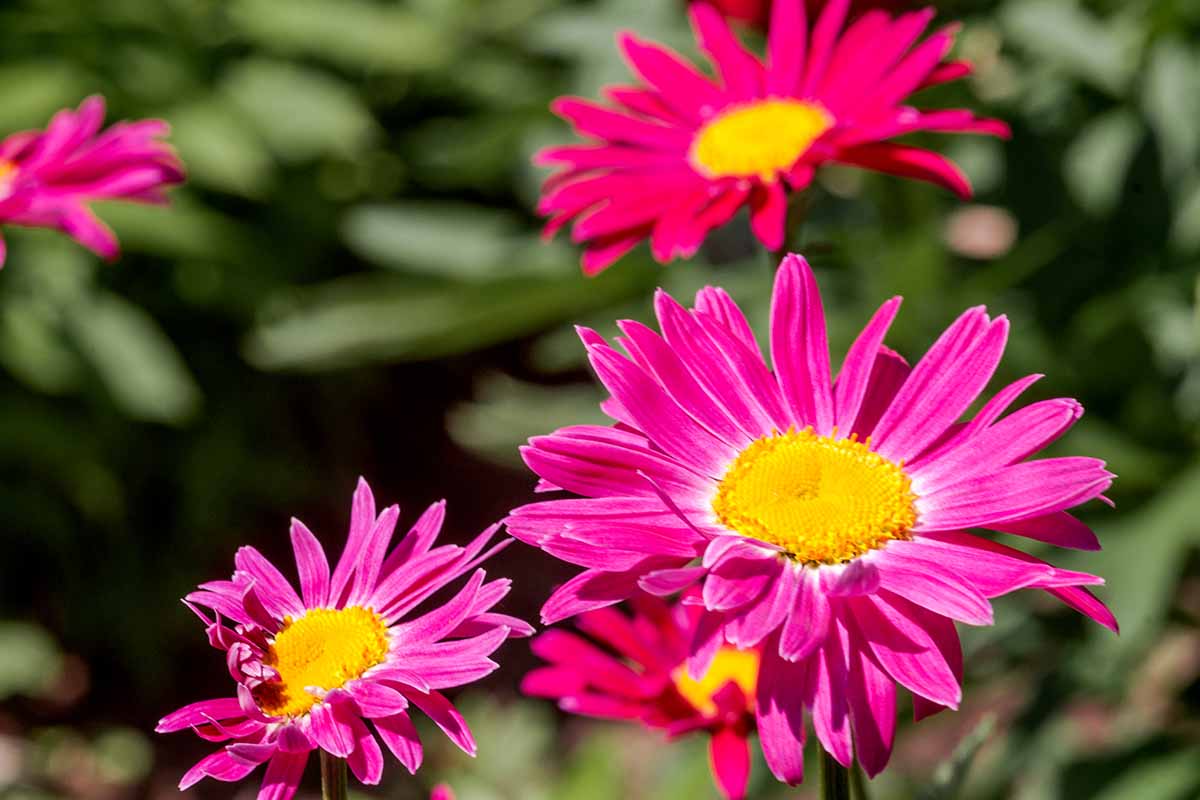
Cut T. coccineum flowers look stunning in arrangements – their tall and slender forms make them the perfect fit for tall and slender vases.
For some easy pest management that couldn’t be more organic, try planting these guys wherever you don’t want bugs to hang out.
Quick Reference Growing Guide
| Plant Type: | Herbaceous flowering perennial | Flower/Foliage Color: | Pink, red, violet, white (petals), yellow (centers)/green |
| Native to: | Southwestern Asia | Water Needs: | Moderate |
| Hardiness (USDA Zones): | 3-7 | Maintenance: | Low |
| Bloom Time: | June-July | Tolerance: | Deer, insects |
| Exposure: | Full sun-partial shade | Soil Type: | Average |
| Spacing: | 18-24 inches | Soil pH: | 6.0-7.0 |
| Planting Depth: | 1/8 inch (seeds), depth of root system (transplants) | Soil Drainage: | Well-draining |
| Height: | 2-3 feet | Uses: | Borders, cottage gardens, cut flowers, groupings, mass planting, pest management |
| Spread: | 1-1.5 feet | Family: | Asteraceae |
| Growth Rate: | Moderate | Genus: | Tanacetum |
| Common Pests and Diseases: | Aphids, chrysanthemum nematodes, leaf miners; root rot | Species: | Coccineum |
You’ll Go Crazy for the Painted Daisy
Not in any diagnosable way, mind you… although a fanatical fervor for this plant may raise a psychologist’s eyebrow.
But if the couch doctor has an ounce of botanical appreciation, then they’ll understand the enthusiasm.

The easy care and splashy colors of T. coccineum truly make the painted daisy a million-dollar standout for gardeners in USDA Zones 3 to 7.
And not only is it a beautiful addition to the landscape, it can pay its caretaker back by repelling bugs, from both itself and nearby plants!
Have you grown this particular daisy? How’d it do for you? Please share tips for other gardeners in the comments section below.
Want even more daisy-growing tips? Check out some of our other growing guides next:

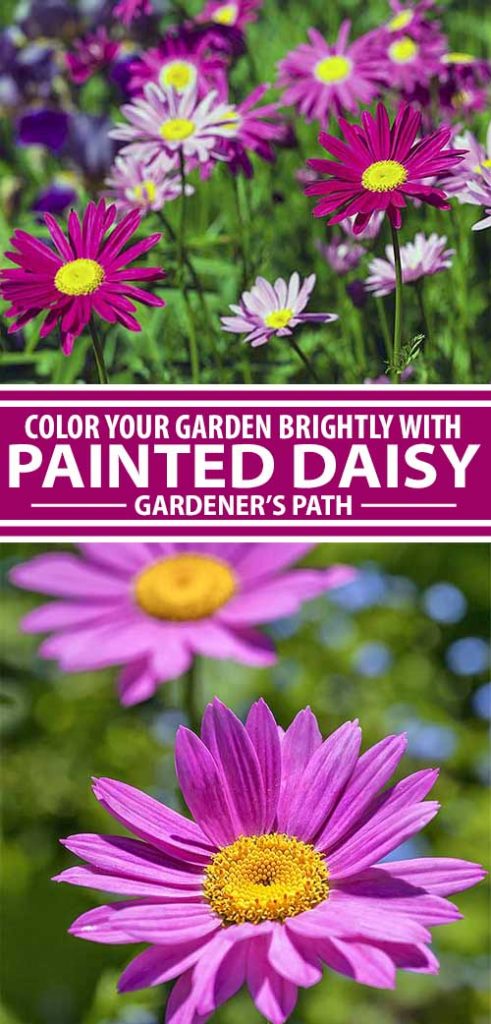

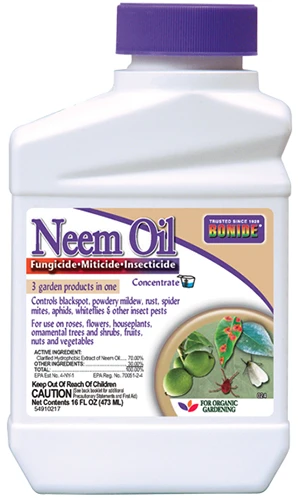
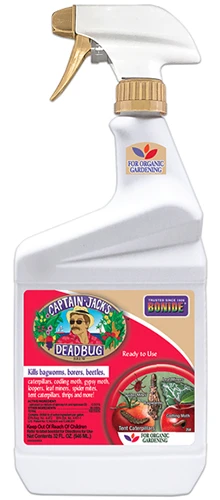
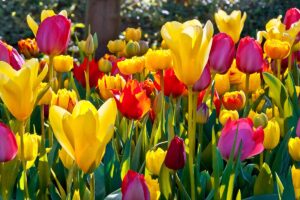
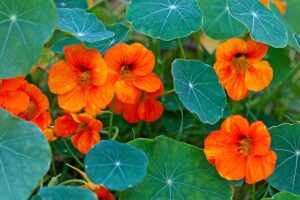
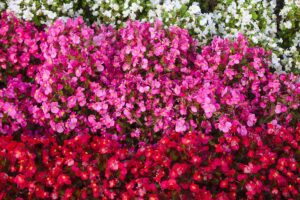
It’s my first time reading about painted daisies, and I must admit that it is such a beautiful flower. It’s amazing that you’ve decided to share this post to everyone. 🙂
Regards!
Thanks for your kind words!
These painted daisies look so beautiful! I would surely like to give it a try.
Diana, let us know how it goes! We’d love to see a photo of your painted daisies!
I’ve just planted my first painted daisy plant…what a show stopper and lots of comments from neighbors about how beautiful it looks at my white mailbox post. I am a new fan of this glorious plant.
Wonderful to hear, Linda!
I planted these by seeds a few years ago and fell in love with them! One of my favorite daisies! They only came back one more season and haven’t seen them since. I’m going to have to order seeds because I haven’t found them again in stores around me.
I’m glad to hear you’ve had success with this plant, Rose. And aren’t we lucky to have so many online resources these days to choose from?
It is mid July in Winnipeg Manitoba, just picked these seeds up at the nursery, can I plant them now? I am thinking that this would give them a head start for next year.
You might have some success planting them now. I would give the seedlings some shade, though, when they are very small.
When is the best time to plant daisies
Hi Dolitha! I would plant the daisies in the springtime, when the chance of frost has passed.
how do people clean all the dead leaves in between the new growth. Is there a special technic to doing this.
Where are you seeing dead leaves, Linda? On the plants or on the ground?
I’ve never had painted daisies before but they look beautiful. My daughter recently received some painted daisy seeds in an envelope from her teacher and i have no idea if these should be planted outdoors in a medium pot, in the ground or if she can start them indoors in a small pot. Any feedback would be awesome.
Where are you located, Kris? Depending on the growing zone, these should do fine if you plant them in the ground now, in a location with a long enough growing season. Otherwise, follow the directions provided above- seeds sown indoors should germinate in 1-2 weeks. Seedlings can be transplanted outdoors, or grown in containers inside if you are able to provide enough light for them to bloom.
We are in Minnesota! Thank you very much for your feedback – much appreciated!!
Is it possible the painted daisy can be just the bushy fern and not have blooms?
Just wondering because the bushy fern looks a lot like a weed we have here in Ohio. Wondering if I’m feeding a weed and not my daisy. Lol
It can certainly be hard to tell with certain plants, particularly before they flower. Can you post a picture, Gregory? Or have you tried any of the plant identification apps, like iNaturalist or PlantSnap?
I just saw this other question from you, Gregory, after replying to the later one. An abundance of leafy foliage and a lack of blooms could be due to having too much nitrogen available in the soil, or a lack of adequate sunlight.
So I decided to pull it after researching some more. I believe it was hemlock. After I pulled it and started to dig the root out there was a plant that I believe to be the daisy. It has buds like a daisy and I’m sure the other was a poison hemlock. They look a lot alike before the buds start showing. Thank you for responding.
You’re welcome! Good luck with the daisy- please feel free to share photos when it blooms. I’m glad you were able to get to the bottom of this, and I hope you wore gloves when you pulled out the poison hemlock!
I have had painted daisies for a number of years. I live in zone 5, of northern Indiana. They do well in sandy soil and while I’ve had a couple die out, I try to let them reseed. They typically don’t bloom the first full year, but will after that. I just love them, and their bold and striking blooms!!